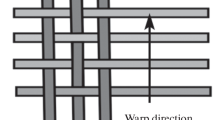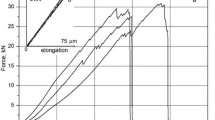Abstract
The paper deals with determination of material characteristics of carbon/epoxy composite due to numerical homogenization and experimental investigation. Within numerical homogenization there is used periodic microstructure model without and with pores. The numerical homogenization and simulation of experiment are provided in FEM program ANSYS. In this study, unidirectional quasi-static tensile test on carbon/epoxy composite laminate is carried out to investigate its material properties. The quasi-static tensile tests were conducted by INOVA FU 160 machine. The extensometer EPSILON 3542 was installed to measure the deformation of the specimen. The experiment was controlled also using video extensometer measuring system ARAMIS. The results obtained from numerical and experimental investigation were compared.
Access provided by Autonomous University of Puebla. Download conference paper PDF
Similar content being viewed by others
Keywords
1 Introduction
Fiber reinforced polymer (FRP) composite is a material made of polymer matrix reinforced with high strength fibers. The quality of fibers, their orientation, shape and fiber volume fraction determine the material properties. These material properties can be obtained from analytical or numerical microstructure fictitious models and experimental investigation.
The microstructure models are based at the class of so-called unit cell methods. The unit cell methods provide valuable information on the local microstructure fields as well as the effective material properties [1, 2]. These properties are generally determined by fitting the averaged microscopic stress-strain fields, resulting from the analysis of a microstructure representative cell subjected to a certain loading. In recent years, a promising alternative approach for the homogenization of engineering materials has been developed, i.e. multi-scale computational homogenization, also called global-local analysis. The basic ideas of this approach have been presented in [3,4,5,6,7,8]. These micro-macro modeling procedures do not lead to closed-form overall constitutive equations, but compute the stress-strain relationship at every point of interest of the macro-component by detailed modeling of the microstructure attributed to that point [9, 10].
From experiment it can be obtained real mechanical properties such as for example strength, failure strain, Young´s modulus and others. The experimental designation of quasi-static and dynamic tensile properties of FRP composite is clarified in works of [11, 12].
2 Microscopic Stress-Strain Field
Most fiber reinforced composites have a random arrangement of the fibers at the micro-scale. A simpler alternative is to assume that the random microstructure is well approximated by the periodic microstructure (Fig. 64.1). With the initiation of the computer technology the concept of the representative volume element (RVE) in combination with a finite element analysis gets more and more importance.
The stiffness tensor of microstructure is written in following form
In order to evaluate the tensor C of the composite, the RVE is subjected to an average strain. The volume average of the strain in the RVE equals the applied strain
The coefficients in C are found by setting a different problem for each column of C. The components Cij i, j = 1,2,3 (z, x, y) of the tensor C are determined by solving three elastic models of RVE with parameters (a1, a2, a3) subjected to the different boundary conditions [13, 14]. By using a unit value of applied strain, it is possible to compute the stress field, whose average gives the required components of the elastic matrix as
For calculation of the component C44, C66 = C55, the following strain is applied to the RVE
The coefficient C44, C66 is calculated as
3 Experiment
The performance of the proposed model is demonstrated on tensile tests of three specimens (Fig. 64.2 (left)). The fiber volume fraction and fiber diameter were found from electron microscope digital shot (Fig. 64.2 (right)). The specimens were cut out from the unidirectional composite plate 250 × 25 × 2 mm made of 16 autoclaved prepreg carbon/epoxy layers, Vf = 0.6. Each layer of the laminate has the same thickness \( {}^{n}h \) = 0.125 mm.
The quasi-static tensile specimens were prepared as per guidelines STN EN ISO 527-4 [15], that stipulate the requirements for the tensile testing of plastics. Each specimen was equipped with aluminum tabs at the ends. The gauge length is 80 mm long and the aluminum tabs are 60 mm long. The tabs with thickness of 1 mm were glued onto the specimens to avoid any possible damage when gripping the specimen.
All layers of specimens have fiber orientations θ = 0°. The dimension of the specimen was adjusted to satisfy the specific requirements by the INOVA FU 160 machine. As shown in Fig. 64.3 (left) an extensometer was installed to measure the deformation of the specimen during the quasi-static test. The machine has an inbuilt load cell to measure the load during the test. An example of tested specimen with attached extensometer is shown in Fig. 64.3 (right).
Three specimens were tested also with the help the videoextensometry by ARAMIS system.
4 Results
The strains were investigated at gauge length. The measured load-displacement and strain-time curves are displayed in Fig. 64.4 (left) and 64.4 (right), respectively.
The displacement u in the graphs corresponds to values from the extensometer with initial length 80 mm. The specimens contain certain amount of primary inter-fiber damage and the final rupture is visible as non-uniform cracking across the specimen width (Fig. 64.5 (left)). Strain distribution obtained from by GOM Aramis software is shown on the Fig. 64.5 (right).
Tensile strength and ultimate strain were obtained by FEM in program ANSYS (Fig. 64.6). The summary of results are written in Tables 64.1 and 64.2.
5 Conclusion
The numerical homogenization within periodic microstructure model without and with pores is considered in the paper. The periodic microstructure model without pores was solved by the FEM.
The computational finite element model of unidirectional fiber-reinforced composite plate is presented in program ANSYS. The performance of the proposed model is demonstrated on example of tensile test. The original supplier material data are adjusted during the quasi-static numerical analysis. The comparison of the results from experiment and simulation shows satisfactory agreement.
References
Sladek, J., Novak, P., Bishay, P.L., Sladek, V.: Effective properties of cement-based porous piezoelectric ceramic composites. Constr. Build. Mater. 190, 1208–1214 (2018)
Murcinkova, Z., Novak, P., Kompis, V., Zmindak, M.: Homogenization of the finite-length fibre composite materials by boundary meshless type methods. Arch. Appl. Mech. 88(5), 789–804 (2018)
Suquet, P.M.: Local and global aspects in the mathematical theory of plasticity. In: Sawczuk, A., Bianchi, G. (eds.) Plasticity Today: Modelling, Methods and Applications, pp. 279–310. Elsevier Applied Science Publishers, London (1985)
Feyel, F., Chaboche, J.-L.: FE2 multiscale approach for modeling the elastoviscoplastic behaviour of long fiber SiC/Ti composite materials. Comput. Methods Appl. Mech. Eng. 183, 309–330 (2000)
Terada, K., Kikuchi, N.: A class of general algorithms for multi-scale analysis of heterogeneous media. Comput. Methods Appl. Mech. Eng. 190, 5427–5464 (2001)
Kouznetsova, V., Brekelmans, W.A.M., Baaijens, F.P.T.: An approach to micro-macro modeling of heterogeneous materials. Comput. Mech. 27, 37–48 (2001)
Miehe, C., Koch, A.: Computational micro-to-macro transition of discretized microstructures undergoing small strain. Arch. Appl. Mech. 72, 300–317 (2002)
Barbero, E.J.: Finite Element Analysis of Composite Materials. CRC Press, USA (2007)
Barretta, R., Luciano, R., Willis, J.R.: On torsion of random composite beams. Compos. Struct. 132, 915–922 (2015)
Lapcik, L., et al.: Effect of filler particle shape on plastic-elastic mechanical behavior of high density poly(ethylene)/mica and poly(ethylene)/wollastonite composites. Compos. Part B 141, 92–99 (2018)
Chen, W., Meng, Q., Hao, H., Ciu, J., Shi, Y.: Quasi-static and dynamic tensile properties of fiberglass/epoxy laminate sheet. Constr. Build. Mater. 143, 247–259 (2017)
Chen, W., Hao, H., Jong, M., Ciu, J., Shi, Y., Chen, L.: Quasi-static and dynamic tensile properties of basalt fibre reinforced polymer. Compos. Part B 125, 123–133 (2017)
Kormanikova, E., Kotrasova, K.: Multiscale modeling of liquid storage laminated composite cylindrical tank under seismic load. Compos. Part B 146, 189–197 (2018)
Vorel, J., Urbanová, S., Grippon, E., Jandejsek, I., Maršálková, M., Šejnoha, M.: Multi-scale modeling of textile reinforced ceramic composites. Ceram. Eng. Sci. Proc. 34(10), 233–245 (2014)
STN EN ISO 527-4: plastics. Determination of tensile properties. Part 4: test conditions for isotropic and orthotopic fibre-reinforced plastic composites (ISO 527-4:1997)
Acknowledgements
This work was supported by the Scientific Grant Agency of the Ministry of Education of Slovak Republic and the Slovak Academy of Sciences under Projects VEGA 1/0374/19 and 1/0078/16. The authors declare that they have no conflict of interest.
Author information
Authors and Affiliations
Corresponding author
Editor information
Editors and Affiliations
Rights and permissions
Copyright information
© 2020 Springer Nature Switzerland AG
About this paper
Cite this paper
Kormanikova, E., Zmindak, M., Sabol, P. (2020). Tensile Properties of Carbon Fiber Reinforced Polymer Matrix Composite. In: Okada, H., Atluri, S. (eds) Computational and Experimental Simulations in Engineering. ICCES 2019. Mechanisms and Machine Science, vol 75. Springer, Cham. https://doi.org/10.1007/978-3-030-27053-7_64
Download citation
DOI: https://doi.org/10.1007/978-3-030-27053-7_64
Published:
Publisher Name: Springer, Cham
Print ISBN: 978-3-030-27052-0
Online ISBN: 978-3-030-27053-7
eBook Packages: EngineeringEngineering (R0)










